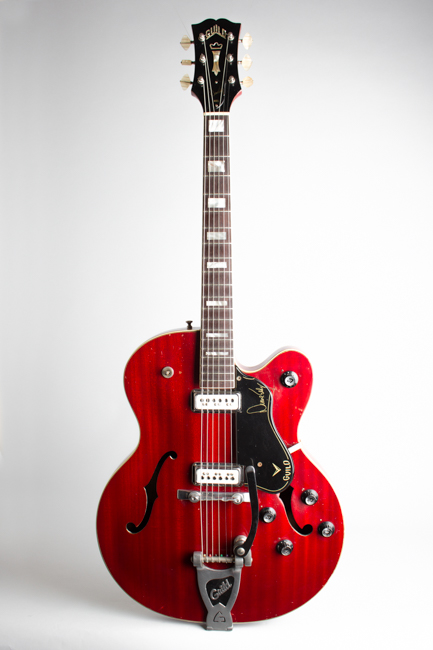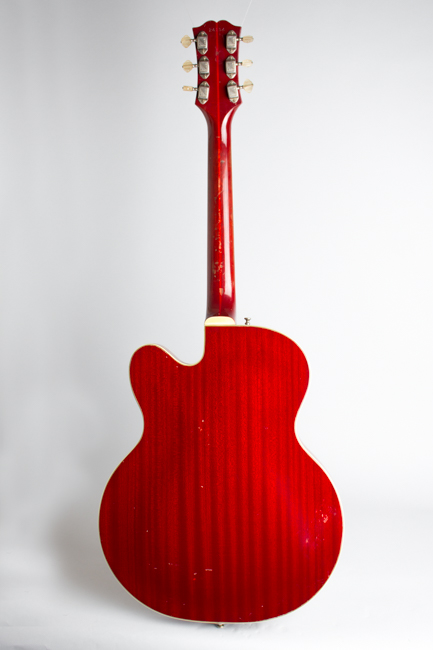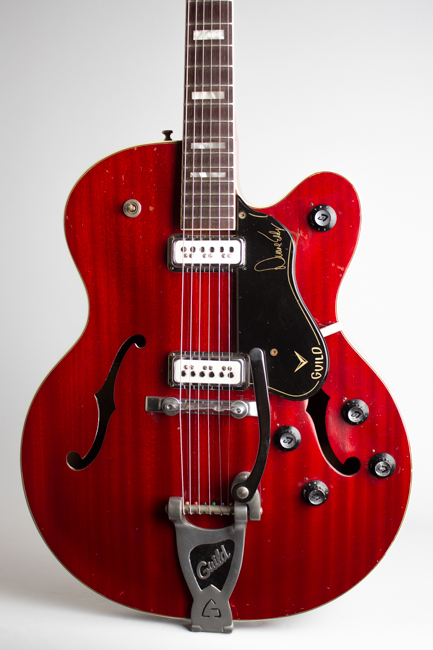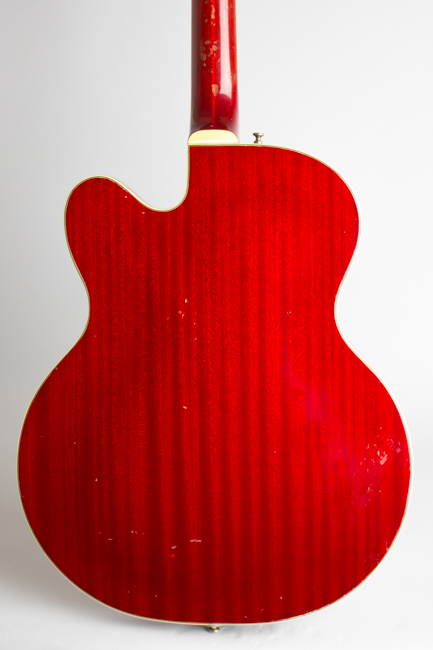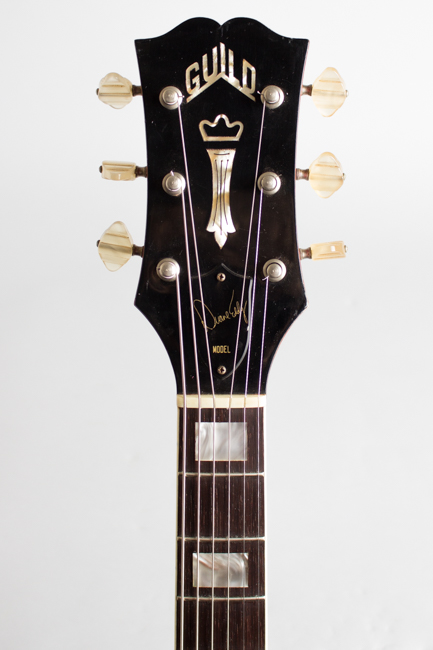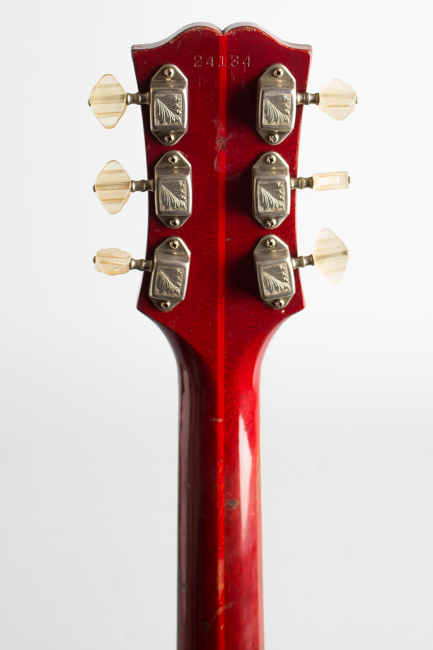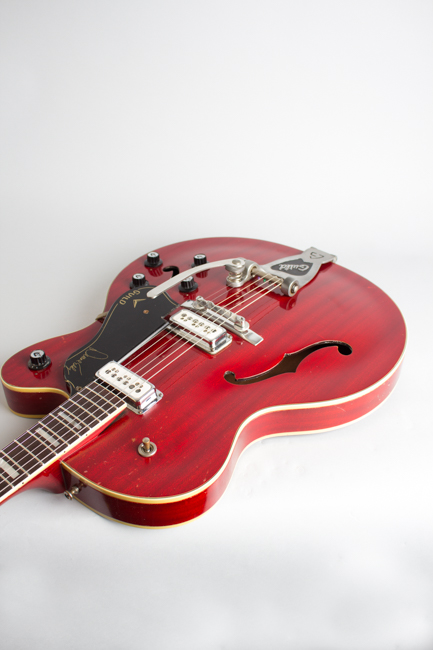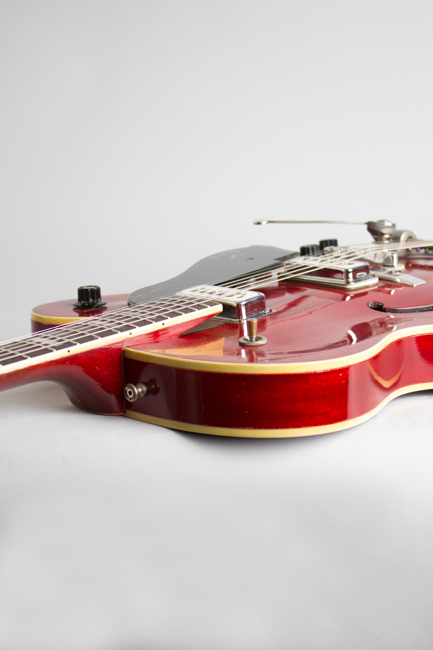Guild Duane Eddy DE-400CH Thinline Hollow Body Electric Guitar (1963)
This item has been sold.
Item # 7681
Prices subject to change without notice.
Guild Duane Eddy DE-400CH Model Thinline Hollow Body Electric Guitar (1963), made in Hoboken, NJ, serial # 24134, cherry lacquer finish, laminated mahogany back and sides, spruce top; laminated mahogany neck with rosewood fingerboard, original black hard shell case.
The DE-400 "Duane Eddy Standard" is one of Guild's less common 1960s offerings, a serious professional-grade guitar with most of the design features of the highly sought-after DE-500 signature model at a somewhat lower price. The Duane Eddy line was inaugurated by Guild in the early 1960s as they jumped at the chance to create an instrument endorsed by the then-top instrumental artist of the time. The first signature model was christened the DE-500, and was a very high-end thinline hollow body introduced in 1962 featuring gold-plated DeArmond pickups, a Bigsby vibrato, and a master volume knob on the cutaway -- features found on his Gretsch 6120.
The next model was the DE-400 (briefly called the "Duane Eddy Junior"), added to the line as a more affordable option with the same construction features but less fancy cosmetics in early 1963, as the rock and roll target audience (i.e. teenagers) were likely not able to pony up in sufficient numbers for Duane's original signature model. Both the DE-500 and DE-400 are among Guild's most highly regarded electric guitars today; they were expensive compared to many similar instruments of the early 1960s, and despite being excellent, practical designs were not good sellers at the time.
This fairly early DE-400 from mid-1963 is built on a thinline 17" single-cutaway body, and has all the more desirable features of the model's first incarnation. It is finished in Guild's 1960s cherry "Starfire" lacquer on all surfaces, which was a rare custom option for this model; Duane's personal instrument was finished in natural. The body is made of laminated maple with an overlay of figured sappeli mahogany, as seen on the far more common Starfire models, and is triple-bound top and back. The pickups are white-top DeArmonds, as originally specified by Duane Eddy but replaced soon after by the company's own humbuckers; this would have been one of the last guitars built with this feature.
The tailpiece is the standard Guild Bigsby unit paired with the aluminum Bigsby adjustable bridge. The bound mahogany neck has a block-inlaid rosewood fingerboard and the headstock has the standard mid-'60s Guild plastic overlay with "Chesterfield" column inlay, with Duane Eddy's name on the truss rod cover -- another feature soon deleted. The tuners are the lovely Kolb units with diamond-shaped plastic buttons, used in this period only on higher-end Guild models. Duane Eddy's signature appears on the back-painted clear pickguard as well.
This guitar has a slightly livelier acoustic sound than the more familiar Starfires, mostly due to the larger body, and a truly great electric sound, similar to a 1950s Gretsch in character. This is quite a versatile instrument, excellent for everything from jazz to country to garage-band rock -- and, of course, Duane Eddy songs! An excellent player and a very cool and seldom-seen fancy 1960s vintage hollow body guitar.
Overall length is 42 in. (106.7 cm.), 17 in. (43.2 cm.) wide at lower bout, and 1 15/16 in. (4.9 cm.) in depth, measured at side of rim. Scale length is 24 3/4 in. (629 mm.). Width of nut is 1 11/16 in. (43 mm.).
This is an excellent playing example, all original except for a more recent Bigsby aluminum bridge and a recent high-grade, period correct refret. There are small spots of finish wear in various places, including some to the top that have been lightly touched up. The only alteration is it looks like long ago the front tip of the back-painted clear plastic pickguard was chipped, and someone rounded down the area just above the master volume control. This is fairly inconspicuous, except that the pinstripe around the pickguard edge is interrupted.
This guitar has an excellent neck angle and is a very fine player; many period Guilds have issues in this area. With two powerful and snappy DeArmonds this is a very fine sounding guitar and a very cool and rare example of one of Guild's all-time best designs. Excellent - Condition.
The DE-400 "Duane Eddy Standard" is one of Guild's less common 1960s offerings, a serious professional-grade guitar with most of the design features of the highly sought-after DE-500 signature model at a somewhat lower price. The Duane Eddy line was inaugurated by Guild in the early 1960s as they jumped at the chance to create an instrument endorsed by the then-top instrumental artist of the time. The first signature model was christened the DE-500, and was a very high-end thinline hollow body introduced in 1962 featuring gold-plated DeArmond pickups, a Bigsby vibrato, and a master volume knob on the cutaway -- features found on his Gretsch 6120.
The next model was the DE-400 (briefly called the "Duane Eddy Junior"), added to the line as a more affordable option with the same construction features but less fancy cosmetics in early 1963, as the rock and roll target audience (i.e. teenagers) were likely not able to pony up in sufficient numbers for Duane's original signature model. Both the DE-500 and DE-400 are among Guild's most highly regarded electric guitars today; they were expensive compared to many similar instruments of the early 1960s, and despite being excellent, practical designs were not good sellers at the time.
This fairly early DE-400 from mid-1963 is built on a thinline 17" single-cutaway body, and has all the more desirable features of the model's first incarnation. It is finished in Guild's 1960s cherry "Starfire" lacquer on all surfaces, which was a rare custom option for this model; Duane's personal instrument was finished in natural. The body is made of laminated maple with an overlay of figured sappeli mahogany, as seen on the far more common Starfire models, and is triple-bound top and back. The pickups are white-top DeArmonds, as originally specified by Duane Eddy but replaced soon after by the company's own humbuckers; this would have been one of the last guitars built with this feature.
The tailpiece is the standard Guild Bigsby unit paired with the aluminum Bigsby adjustable bridge. The bound mahogany neck has a block-inlaid rosewood fingerboard and the headstock has the standard mid-'60s Guild plastic overlay with "Chesterfield" column inlay, with Duane Eddy's name on the truss rod cover -- another feature soon deleted. The tuners are the lovely Kolb units with diamond-shaped plastic buttons, used in this period only on higher-end Guild models. Duane Eddy's signature appears on the back-painted clear pickguard as well.
This guitar has a slightly livelier acoustic sound than the more familiar Starfires, mostly due to the larger body, and a truly great electric sound, similar to a 1950s Gretsch in character. This is quite a versatile instrument, excellent for everything from jazz to country to garage-band rock -- and, of course, Duane Eddy songs! An excellent player and a very cool and seldom-seen fancy 1960s vintage hollow body guitar.
Overall length is 42 in. (106.7 cm.), 17 in. (43.2 cm.) wide at lower bout, and 1 15/16 in. (4.9 cm.) in depth, measured at side of rim. Scale length is 24 3/4 in. (629 mm.). Width of nut is 1 11/16 in. (43 mm.).
This is an excellent playing example, all original except for a more recent Bigsby aluminum bridge and a recent high-grade, period correct refret. There are small spots of finish wear in various places, including some to the top that have been lightly touched up. The only alteration is it looks like long ago the front tip of the back-painted clear plastic pickguard was chipped, and someone rounded down the area just above the master volume control. This is fairly inconspicuous, except that the pinstripe around the pickguard edge is interrupted.
This guitar has an excellent neck angle and is a very fine player; many period Guilds have issues in this area. With two powerful and snappy DeArmonds this is a very fine sounding guitar and a very cool and rare example of one of Guild's all-time best designs. Excellent - Condition.
